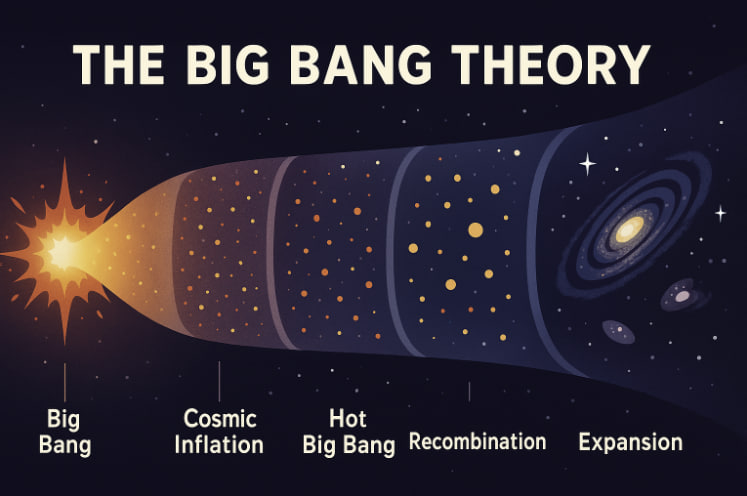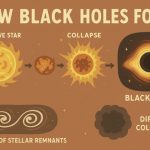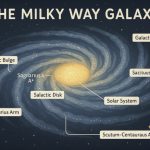The Big Bang Theory is the leading scientific explanation for the origin and evolution of the universe. It proposes that the universe began from an extremely hot, dense point about 13.8 billion years ago, and has been expanding ever since. Contrary to what the name may suggest, the Big Bang wasn’t an explosion in space—it was an expansion of space itself.
What Was the Big Bang?
The “Big Bang” refers to the moment when:
- All matter, energy, space, and time were compressed into a single, infinitely dense point (a singularity).
- Around 13.8 billion years ago, this singularity began to expand rapidly in all directions.
- In a fraction of a second, the universe underwent cosmic inflation, growing exponentially.
This event created space-time itself—there was no “before” the Big Bang in the conventional sense.
Key Stages After the Big Bang
- Inflation (~10⁻³⁶ seconds after)
- The universe expanded faster than the speed of light.
- Tiny quantum fluctuations stretched into the seeds of galaxies.
- Hot Big Bang (up to 3 minutes)
- The universe was a hot plasma of particles and radiation.
- Protons and neutrons formed the first atomic nuclei.
- Recombination (380,000 years later)
- Electrons combined with nuclei to form neutral atoms.
- The universe became transparent—light could travel freely.
- This light is observed today as the Cosmic Microwave Background (CMB).
- Structure formation
- Gravity pulled matter together into stars, galaxies, and clusters over billions of years.
- Dark matter played a key role in shaping the large-scale structure.
Evidence Supporting the Big Bang
- Cosmic Microwave Background (CMB): Faint, uniform radiation leftover from the early universe, discovered in 1965.
- Redshift of galaxies: Light from distant galaxies is stretched to longer wavelengths, showing that the universe is still expanding.
- Abundance of light elements: Observations of hydrogen, helium, and lithium match predictions from Big Bang nucleosynthesis.
- Large-scale structure: Galaxy distribution aligns with models starting from early fluctuations in the CMB.
What the Big Bang Is Not
- Not an explosion in space—it was the rapid expansion of space.
- Not the creation of matter inside a void—space, time, and energy were created simultaneously.
- It doesn’t tell us why the Big Bang happened—only what happened after it began.
Open Questions
- What caused the Big Bang?
- What is dark energy, and how does it affect the fate of the universe?
- What happened during inflation, and can we detect traces of it?
- Are we part of a multiverse?
The Big Bang Theory remains the best model we have, but it continues to evolve with new data from telescopes and particle physics experiments.
Glossary
- Singularity — A point of infinite density and zero volume where known physics breaks down.
- Cosmic inflation — A rapid expansion of the early universe before the hot Big Bang.
- CMB (Cosmic Microwave Background) — The afterglow of the early universe, still observable today.
- Redshift — A stretching of light waves that indicates motion away from the observer.
- Nucleosynthesis — The formation of new atomic nuclei during the early universe.


